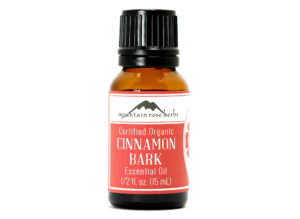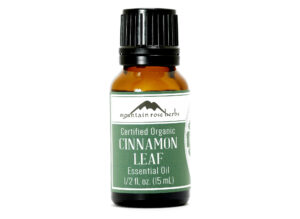Cinnamon Essential Oil
Cinnamon–the meaning of which is sweet wood–is a spice that comes from inside the bark of a tree. Although the tree is native to Sri Lanka–producer of the highest grade of cinnamon–India and Brazil also grow cinnamon trees for commercial purposes. A similar tree–the Cassia–is native to China. In ancient times, cinnamon from these regions of the world was considered a valuable trade commodity.
History
Cinnamon was first grown in Southeast Asia, with its use noted as early as the 1500s. It has a long history of use in India and Sri Lanka, playing a significant role in Indian and Chinese cultures spanning hundreds of years.
Cinnamon was used for both practical and exotic purposes, including use as an ingredient in love potions. The ancient Greeks used cinnamon oil for incense in their temples. In addition to using it in their embalming potions, the ancient Egyptians used cinnamon to treat a wide range of physical ailments.
Harvesting the Plant Material to Extract Oil
Cinnamon trees can grow to be 45 feet in height, but those that are harvested for commercial use generally are not left to grow taller than six feet. Grown on commercial plantations, the trees are cut–a process known as coppicing–so that they look more like bushes. This increases the yield and makes harvesting the plant materials easier.
Although cinnamon oil is extracted from both the leaves and bark of the tree, higher amounts of oil are obtained from the leaves through the process of distillation. But it’s the bark oil that has anti-microbial and anti-fungal properties. The bark oil also produces the sweet, spicy aroma.
Use As an Ingredient in Skincare Products
Cinnamon contributes to healthy skin by increasing circulation, which not only improves skin health, but also reduces the signs of aging. Cinnamon essential oil and pastes moisturize the skin and are used to treat chronic skin conditions such as eczema and acne. However, since skin can be sensitive to cinnamon, it’s important to test it by first applying it to a small area.
You should also avoid applying skin care products containing cinnamon oil near the eyes or mucous membranes lining the mouth or nose. Keep in mind that essential oils are highly concentrated and potent. That’s why you need to use only a small amount.
Health Benefits
According to folklore, cinnamon has many potential health benefits. Cinnamon oil is rich in minerals and contains antioxidants, natural antibiotics, and anti-inflammatory and antiseptic agents. While these properties make it a useful complementary therapy for a range of common illnesses and injuries, you should consult with your doctor before undertaking any alternative treatment.
Some people use cinnamon to help lower blood pressure and blood sugar levels. While studies show mixed results, some research suggests that cassia cinnamon (known as Chinese cinnamon) may help lower both blood pressure and blood sugar levels in individuals with type 2 diabetes. Caution: Note that cassia cinnamon taken in large doses or in combination with certain pharmaceutical drugs can increase the risk of liver damage.
While many Eastern civilizations have long used cinnamon to treat cold viruses and the flu, some studies suggest the potential of alternative therapies, such as herbal medicines, in helping to fight off these illnesses. Although more research is needed, certain components found in medicinal herbs and spices may also lower the risk of cancer by acting as pro-inflammatory inhibitors; preventing normal cells from changing into cancer cells; preventing the growth of cancer cells; or reducing tumor proliferation.
Buy Organic Cinnamon Bark Essential Oil
Organic cinnamon bark oil is steam distilled from the dried bark of Cinnamomum zeylanicum. With properties of both a middle and base note, warm and spicy cinnamon bark essential oil is great in aromatherapy blends with other oils such as nutmeg, mandarin, rose, or clove.
Cinnamon has been a highly prized commodity since antiquity and is one of the most recognizable scents in the world. Cinnamaldehyde is the main constituent in the bark oil. It is used in perfumery to give a blend lift and strength, and is considered a mild fixative. Use this oil with caution in soap making, because it may darken the color of your product.
Blends Well With
Benzoin, bergamot, cardamom, clove, frankincense, ginger, grapefruit, lemon, mandarin, marjoram, nutmeg, orange, peppermint, peru balsam, petitgrain, rose, vanilla, and ylang ylang
Packaging
1/2 oz. and 1 oz. essential oils are packaged in amber glass bottles with drop reducers for easy application. Larger sizes are packaged in amber screw cap bottles and do not come with reducers or droppers.
Precautions
This oil may interact with certain drugs, it may inhibit blood clotting, cause skin sensitization, mucous membrane irritation, and is potentially embryotoxic. Exercise extreme caution for topical use. Never use essential oils undiluted, in eyes or mucus membranes. Do not take internally unless working with a qualified and expert practitioner. Keep away from children.
Before using topically, perform a small patch test on your inner forearm or back by applying a small quantity of diluted essential oil and apply a bandage. Wash the area if you experience any irritation. If no irritation occurs after 48 hours it is safe to use on your skin.
Buy Organic Cinnamon Leaf Essential Oil
Organic cinnamon leaf oil is steam distilled from the leaves of Cinnamomum zeylanicum. This middle note oil has a sweet, earthy, and spicy aroma great for perfume and aromatherapy blends. Cinnamon leaf essential oil has a higher eugenol content than the bark oil, and combines well with cardamom, grapefruit, peru balsam, and peppermint essential oils.
Blends Well With
Benzoin, bergamot, cardamom, clove, frankincense, ginger, grapefruit, lemon, mandarin, marjoram, nutmeg, orange, peppermint, peru balsam, petitgrain, rose, vanilla, and ylang ylang
Packaging
1/2 oz. and 1 oz. essential oils are packaged in amber glass bottles with drop reducers for easy application. Larger sizes are packaged in amber screw cap bottles and do not come with reducers or droppers.
Precautions
This oil may interact with certain drugs, it may inhibit blood clotting, cause skin sensitization, mucous membrane irritation, and may contain safrole. Never use essential oils undiluted, in eyes or mucus membranes. Do not take internally unless working with a qualified and expert practitioner. Keep away from children.
Before using topically, perform a small patch test on your inner forearm or back by applying a small quantity of diluted essential oil and apply a bandage. Wash the area if you experience any irritation. If no irritation occurs after 48 hours it is safe to use on your skin.



